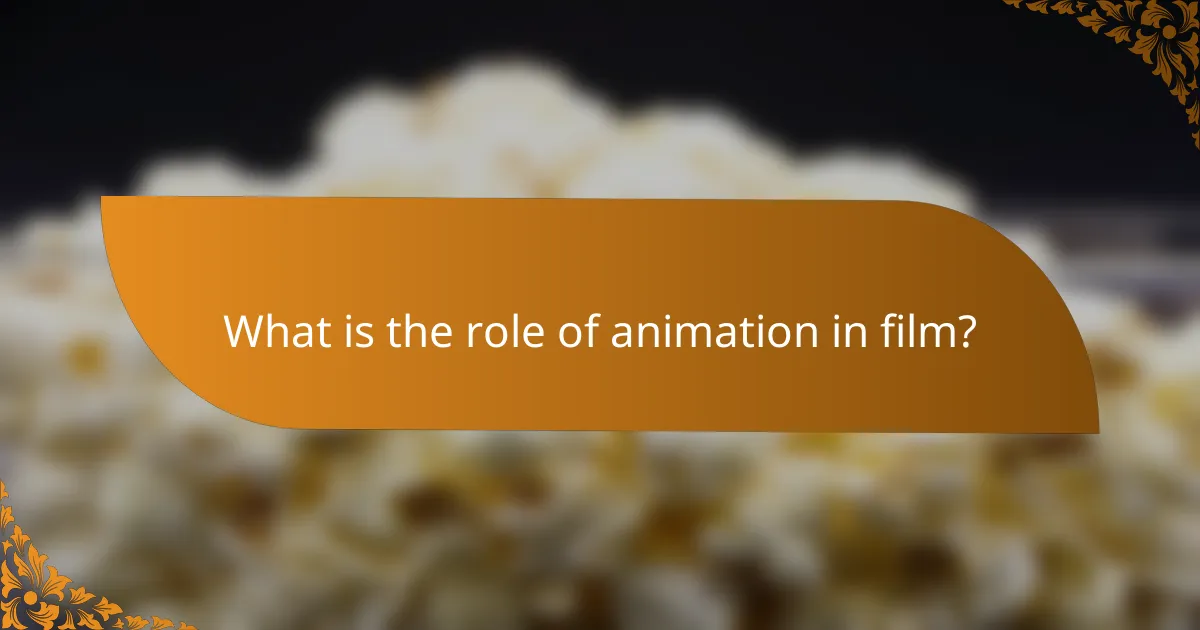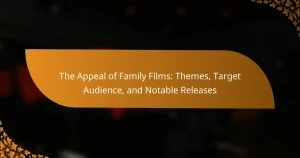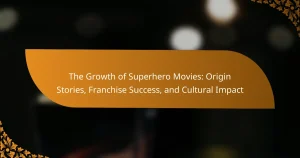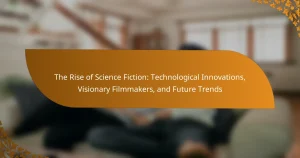
What is the role of animation in film?
Animation serves as a vital storytelling tool in film. It allows for the creation of visually engaging narratives that can convey complex emotions and ideas. Animation can bring to life characters and worlds that are impossible to achieve with live-action alone. It enables filmmakers to explore imaginative concepts and fantastical elements. Animated films often appeal to a wide audience, transcending age and cultural barriers. For instance, Disney’s animated features have garnered global acclaim and box office success, demonstrating animation’s broad appeal. Additionally, animation techniques can enhance visual effects in live-action films, creating a seamless blend of reality and fantasy.
How has animation evolved in the film industry?
Animation has evolved significantly in the film industry since its inception. Early animation started in the late 19th century with techniques like stop-motion and hand-drawn frames. The introduction of synchronized sound in the 1920s, exemplified by “Steamboat Willie,” marked a pivotal moment. The 1930s saw the rise of feature-length animated films, notably Disney’s “Snow White and the Seven Dwarfs.”
The 1990s introduced computer-generated imagery (CGI), revolutionizing animation with films like “Toy Story.” This shift allowed for more complex visuals and storytelling. In the 2000s, advancements in technology further enhanced animation quality, enabling realistic textures and lighting. The rise of 3D animation has since dominated the industry, with studios like Pixar and DreamWorks leading the way.
Today, animation encompasses various styles, including traditional, CGI, and hybrid forms. It has expanded into diverse genres, appealing to broader audiences. The evolution of animation reflects technological advancements and changing audience preferences throughout the years.
What are the key milestones in the history of animation?
The key milestones in the history of animation include several significant developments. The first animated film, “Humorous Phases of Funny Faces,” was created by J. Stuart Blackton in 1906. In 1914, Gertie the Dinosaur by Winsor McCay introduced character animation. Walt Disney’s “Steamboat Willie,” released in 1928, was the first synchronized sound cartoon. The introduction of Technicolor in 1932 enhanced animation’s visual appeal. Disney’s “Snow White and the Seven Dwarfs,” released in 1937, was the first full-length animated feature film. The 1960s saw the rise of television animation with shows like “The Flintstones.” The 1990s introduced CGI with Pixar’s “Toy Story,” the first fully computer-animated feature. The 2000s and beyond have seen advancements in 3D animation techniques, exemplified by films like “Frozen” (2013). Each of these milestones has shaped the evolution of animation in film.
How do technological advancements influence animation techniques?
Technological advancements significantly influence animation techniques by enhancing visual quality and streamlining production processes. Modern software allows for greater detail and realism in animated characters and environments. For instance, computer-generated imagery (CGI) has transformed traditional animation by enabling complex 3D modeling. Motion capture technology captures real-life movements, improving character animation fluidity. Additionally, advancements in rendering technology reduce production time while increasing output quality. The use of artificial intelligence in animation assists in automating repetitive tasks, further optimizing workflow. Historical milestones, such as Pixar’s use of RenderMan, demonstrate the impact of technology on animation evolution. These developments have expanded creative possibilities and audience engagement in animated films.
What are the main techniques used in animation for film?
The main techniques used in animation for film include traditional animation, computer-generated imagery (CGI), stop-motion animation, and motion graphics. Traditional animation involves creating hand-drawn images that are sequenced to create movement. This technique has been used since the early days of animation, exemplified by Disney classics. Computer-generated imagery (CGI) uses digital tools to create 3D models and environments, revolutionizing animation since the 1990s. Stop-motion animation involves photographing physical objects in small increments to create the illusion of movement, seen in films like “The Nightmare Before Christmas.” Motion graphics combine graphic design and animation techniques to create engaging visual content, often used in title sequences and advertisements. Each technique has distinct characteristics and applications, contributing to the diverse landscape of animated films.
What are the differences between 2D and 3D animation?
2D animation uses two dimensions, while 3D animation incorporates three dimensions. In 2D animation, characters and backgrounds are flat images. This technique relies on creating the illusion of movement through frame-by-frame sequences. Classic examples include hand-drawn animations like Disney’s “Snow White.”
In contrast, 3D animation involves modeling objects in a three-dimensional space. This allows for more realistic movements and perspectives. 3D animations can be manipulated from various angles, providing depth and realism. Films like “Toy Story” showcase the capabilities of 3D animation.
The production processes also differ significantly. 2D animation typically requires less time and resources than 3D animation. 3D animation often involves complex software, like Autodesk Maya or Blender, to create lifelike characters and environments.
In summary, 2D animation is flat and traditional, while 3D animation is dynamic and realistic. Each has unique techniques and applications in the film industry.
How do stop-motion and computer-generated imagery (CGI) compare?
Stop-motion and computer-generated imagery (CGI) are both animation techniques used in film. Stop-motion involves photographing physical objects frame by frame to create movement. This technique often uses puppets or models, resulting in a tangible, textured look. In contrast, CGI involves creating images using computer software. CGI allows for more complex and dynamic visuals, as it can simulate environments and characters that do not exist in reality.
Stop-motion has a long history, dating back to the early 20th century. Iconic films like “The Nightmare Before Christmas” showcase its unique aesthetic. CGI gained prominence in the 1990s, with films like “Jurassic Park” demonstrating its capabilities. Both techniques can evoke strong emotional responses from audiences, but they do so in different ways. Stop-motion offers a handcrafted feel, while CGI provides limitless possibilities for creativity and realism.
What audience appeal does animation in film have?
Animation in film appeals to audiences through its visual creativity and storytelling capabilities. It captivates viewers of all ages by presenting imaginative worlds and characters. The vibrant colors and dynamic movements engage the audience’s attention. Animation often simplifies complex themes, making them accessible to younger viewers. It allows for unique artistic expressions that live-action cannot achieve. The emotional resonance of animated characters can foster strong connections with the audience. According to a study by the Animation Guild, animated films consistently perform well at the box office, indicating their broad appeal. Films like “Toy Story” and “Frozen” exemplify how animation can resonate emotionally with audiences, leading to critical and commercial success.
How does animation attract different age groups?
Animation attracts different age groups through diverse storytelling techniques, visual styles, and relatable characters. Children are drawn to bright colors and simple narratives. They enjoy humor and fantasy elements that stimulate imagination. For teenagers, animation often explores more complex themes and character development. This age group appreciates relatable struggles and social issues depicted in animated forms. Adults are attracted to animation that incorporates sophisticated humor and artistic expression. Many [censured]-oriented animations tackle serious subjects while maintaining an engaging style. Animation also appeals across generations through nostalgia, as many adults enjoy animated films from their childhood. The variety in animation allows it to resonate with a broad audience, making it a versatile medium for storytelling.
What emotional responses does animated film evoke in viewers?
Animated films evoke a wide range of emotional responses in viewers. Common emotions include joy, sadness, fear, and nostalgia. Joy often arises from humor and uplifting storylines. Sadness can be triggered by poignant character arcs or tragic events. Fear may stem from suspenseful scenes or dark themes. Nostalgia is frequently evoked through familiar characters or settings from childhood. Research indicates that animated films can effectively engage audiences emotionally due to their visual storytelling techniques. For instance, a study by the University of Southern California found that animation can enhance emotional resonance by creating vivid, relatable characters. This emotional engagement is crucial for audience connection and retention.
What are some notable works that showcase animation in film?
Notable works that showcase animation in film include “Toy Story,” “Spirited Away,” and “The Lion King.” “Toy Story,” released in 1995, was the first entirely computer-animated feature film. It revolutionized the animation industry and received critical acclaim. “Spirited Away,” directed by Hayao Miyazaki, won the Academy Award for Best Animated Feature in 2003. The film is renowned for its artistic style and storytelling. “The Lion King,” released in 1994, is celebrated for its animation and musical score. It remains one of Disney’s most successful animated films. These works are significant milestones in animation history, showcasing various techniques and storytelling methods.
Which animated films have made significant cultural impacts?
Animated films that have made significant cultural impacts include “Snow White and the Seven Dwarfs,” “The Lion King,” and “Toy Story.” “Snow White,” released in 1937, was the first full-length animated feature and set the standard for future films. “The Lion King,” released in 1994, introduced themes of identity and responsibility, resonating globally. “Toy Story,” released in 1995, pioneered computer animation and changed the animation landscape. Each of these films has influenced storytelling, animation techniques, and cultural discussions within society.
How do award-winning animated films set industry standards?
Award-winning animated films set industry standards through innovation, storytelling, and technical excellence. These films often introduce groundbreaking animation techniques that influence future projects. For instance, Pixar’s “Toy Story” pioneered computer-generated imagery in feature films, setting a new benchmark for visual quality. Additionally, award-winning films frequently explore complex themes and emotional depth, elevating the narrative potential of animation. “Spirited Away,” which won an Academy Award, showcases mature storytelling that resonates with diverse audiences. The success of these films often leads to increased investment in animation as a serious art form. As a result, studios strive to replicate their achievements, pushing the boundaries of creativity and technology in animation.
How can filmmakers effectively utilize animation techniques?
Filmmakers can effectively utilize animation techniques by integrating them seamlessly into storytelling. Animation enhances visual appeal and engages audiences emotionally. Techniques such as 2D animation, 3D animation, and stop-motion can bring characters and narratives to life. For instance, Pixar’s use of 3D animation in films like “Toy Story” showcases depth and realism. Additionally, blending live-action with animation can create unique visual experiences, as seen in “Who Framed Roger Rabbit.” Filmmakers should also consider the pacing and timing of animations to maintain audience interest. Effective sound design paired with animation can further amplify emotional impact. Ultimately, the strategic use of animation techniques can elevate a film’s overall quality and viewer engagement.
What best practices should filmmakers follow when integrating animation?
Filmmakers should ensure that animation complements the live-action elements. This creates a cohesive visual experience. They must also maintain a consistent style throughout the film. Consistency helps the audience engage with the story. Filmmakers should consider the narrative purpose of the animation. Animation should enhance storytelling rather than distract from it. Collaborating closely with animators is crucial for effective integration. This collaboration ensures that animation aligns with the director’s vision. Testing the animation with target audiences can provide valuable feedback. Audience reactions can guide adjustments for better integration. Finally, filmmakers should leverage animation technology effectively. Utilizing the latest tools can enhance the quality of the final product.
How can animation enhance storytelling in film?
Animation enhances storytelling in film by providing visual creativity and emotional depth. It allows filmmakers to depict fantastical elements that live-action cannot easily achieve. Animation can convey complex themes through symbolic imagery. For instance, films like “Spirited Away” use animation to explore identity and transformation. The flexibility of animation supports varied storytelling styles, from humor to drama. It engages audiences of all ages, making stories more accessible. Animation also enables exaggerated expressions and movements, amplifying emotional responses. This technique creates memorable characters, enhancing viewer connection. Overall, animation serves as a powerful tool for narrative expression in film.
The main entity of this article is animation in film, which serves as a crucial storytelling medium that enhances visual narratives and emotional engagement. The article covers the evolution of animation techniques, highlighting significant milestones from early hand-drawn animations to modern CGI advancements. It explores various animation styles, including 2D, 3D, stop-motion, and their unique attributes, while also discussing how animation appeals to diverse audiences across different age groups. Additionally, notable works and award-winning films are examined for their cultural impact and industry standards, emphasizing best practices for filmmakers in integrating animation effectively to enhance storytelling.


